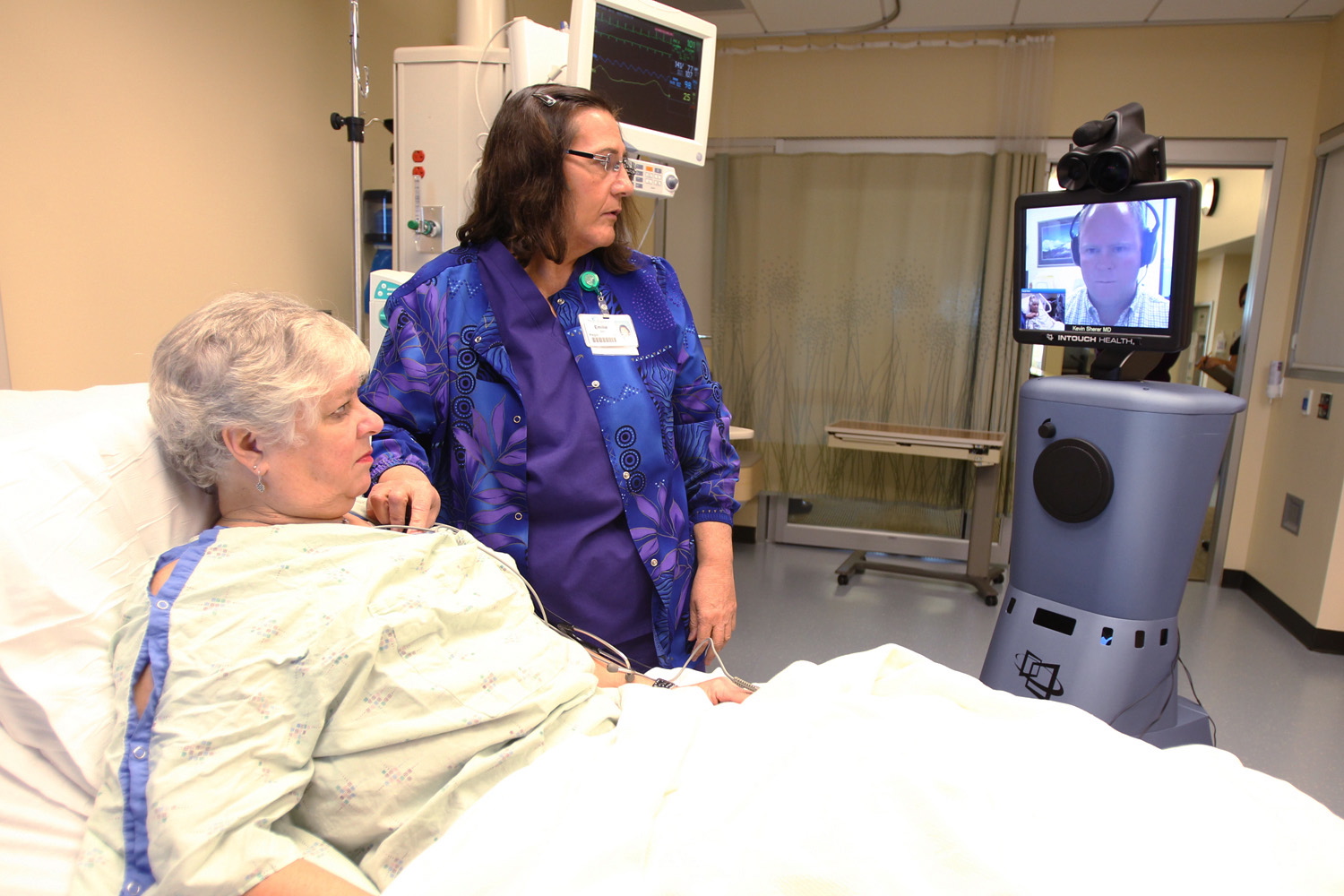REDMOND, Ore. — Sitting more than 20 miles away, Dr. Kevin Sherer performed a quick exam this week on a volunteer in a Redmond hospital bed.
Sherer, a pulmonologist and critical care specialist in Bend, popped up on a screen that serves as the head of a roughly 5-foot-tall robot.
He listened to Anita Boucher’s breathing through a stethoscope and, deftly pivoting the screen, turned to observe her heartbeat on a monitor overhead.
He then piloted the robot out of the room and down the hall.
The scene was a test run for both Sherer and one of St. Charles Redmond’s newest caregivers.
Roda — a Robotic Office Diagnostic Assistant — might start meeting patients as soon as Monday. The robot will let doctors at St. Charles Bend speak with and assess patients in Redmond’s intensive care unit.
The ultimate goal, said Redmond ICU Supervisor Daniel Davis, is to better judge whether patients can remain in Redmond or should be moved to another facility.
“The goal is to better utilize our critical care beds in Central Oregon,” he said. “It’s to keep them here if we can rather than sending them to Bend or Portland or Eugene.”
When a person’s condition is borderline, caregivers might transfer the patient to Bend to get specialties and services not available in Redmond.
That scenario gets more complicated if the 17 beds at St. Charles Bend’s ICU are full, as happens on occasion, so patients must be transported over the Cascades.
It’s those situations caregivers want to avoid, said Janet Seibold, director of inpatient services at St. Charles Redmond. Transferring patients can be risky, depending on their condition, and is stressful for everyone involved.
“It’s better to keep patients in their communities and near their families,” she said.
Redmond caregivers already regularly consult counterparts in Bend by phone, Davis said. With Roda, Bend physicians will be better able to offer their expertise.
“More than anything, I think it’s going to provide support to the Redmond ICU to give them assistance and confidence with their patients,” said Susan Kinney, a nurse supervisor at St. Charles Bend.
The technology has been around for a few years, said Emilie Bonney, a Redmond ICU nurse. Rural hospitals have used such robotics to access expertise over great distances.
Roda provides that assistance through impressive technology. Physicians with a screen and joystick can examine the dilation of a patient’s pupils and watch capillaries refill after pressure is applied to a fingertip.
“The picture is amazing,” Seibold said. “It shows great detail.”
To listen to a patient’s heart and lungs, Roda comes with a high-tech stethoscope attached by a cord. The doctor puts on headphones to listen.
Davis anticipates plugging the robot directly into diagnostic equipment to show readings to doctors remotely.
Since Roda arrived in Redmond about a month ago, caregivers in both the Bend and Redmond ICUs have been training with the technology.
Nurses in Redmond assist the physicians in Bend with consultations. For instance, a nurse helped Sherer on Wednesday by placing the stethoscope on the patient. At one point, Sherer displayed the patient’s body on the screen and used a red arrow to show where to put it.
Staff in Redmond have already adopted Roda into the family. They picked the name for the robot and refer to it as a girl, since it says things like, “I’m ready,” in a polite, female voice.
Down the line, other robots could be purchased to provide similar assistance at the hospitals in Prineville and Madras, the latter of which is expected to come into the St. Charles Health System in January. The robots do, however, cost roughly $95,000 apiece.
While Roda is starting in the ICU, eventually doctors with other specialties might be trained to use the robot, Seibold said. For instance, Roda could be used to help examine stroke or emergency room patients.
“This will be a good thing for patients,” she said.



